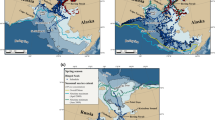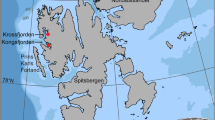Abstract
Most activities of Weddell seals (Leptonychotes weddellii) occur during under-ice dives that extend hundreds to thousands of meters and require the seals to hold their breath for 15 min or more. In the fast-ice environment of Antarctica, holes in the ice where seals can surface to breathe are scarce. Consequently, seals must return to a previous breathing hole or locate a new one to avoid drowning; how they navigate underwater with such precision is not known. This study individually displaced ten seals, each fitted with an archival data logger, to unfamiliar locations and analyzed the three dimensional paths of voluntary dives to test eight predictions under four hypothesized way-finding tactics: geomagnetic sensitivity, path integration, pilotage, and hydrodynamic trail following. Analyses of dive tracks provided strong evidence that Weddell seals primarily used pilotage via visible, overhead features to return home during individual dives under ice cover. Upon release at an unfamiliar location, long-distance diving began only after a period of short-distance diving. Outbound paths of dives progressively increased in distance from home. Homeward paths were remarkably straight and oriented directly toward home, or they traveled to a frequented route then turned toward home. Seventy-five percent of the frequented routes were directly below known linear disturbances in the snow on the top of the sea ice. There was little evidence that seals used geomagnetic or hydrodynamic cues, nor that homing ability was hindered by low light levels (twilight). These results contribute to a growing body of literature indicating that animals can learn to use artificial, and sometimes ephemeral landmarks to guide their movements. How Weddell seals are able to dive during polar winter, with only starlight and moonlight to illuminate landmarks, remains unknown.










Similar content being viewed by others
Data availability
The datasets used in the analyses reported here are available in the Texas Data Repository (https://data.tdl.org), via [https://doi.org/10.18738/T8/OQRUPJ].
References
Batschelet E (1981) Circular statistics in biology. Academic Press, London
Biro D, Meade J, Guilford T (2004) Familiar route loyalty implies visual pilotage in the homing pigeon. Proc Natl Acad Sci USA 101:17440–17443. https://doi.org/10.1073/pnas.0406984101
Biro D, Freeman R, Meade J, Roberts S, Guilford T (2007) Pigeons combine compass and landmark guidance in familiar route navigation. Proc Natl Acad Sci USA 104:7471–7476. https://doi.org/10.1073/pnas.0701575104
Boles LC, Lohmann KJ (2003) True navigation and magnetic maps in spiny lobsters. Nature 421:60–63. https://doi.org/10.1038/nature01226
Bowditch N (1995) The American practical navigator. Defense Mapping Agency Hydrographic/Topographic Center, Bethesda
Burda HS, Begall S, Cerveny J, Neef J, Nemec P (2009) Extremely low-frequency electromagnetic fields disrupt magnetic alignment of ruminants. Proc Natl Acad Sci USA 106:5708–5713. https://doi.org/10.1073/pnas.0811194106
Castellini MA, Kooyman GL (2006) Length, girth and mass relationships in Weddell seals (Leptonychotes weddelli). Mar Mamm Sci 6:75–77. https://doi.org/10.1111/j.1748-7692.1990.tb00227.x
Davis RW (2019) Marine mammals: adaptations for an aquatic life. Springer, Berlin, p 302. https://doi.org/10.1007/978-3-319-98280-9
Davis RW, Fuiman LA, Williams TM, Collier SO, Hagey WP, Kanatous SB, Kohin S, Horning M (1999) Hunting behavior of a marine mammal beneath the Antarctic fast-ice. Science 283:993–996. https://doi.org/10.1126/science.283.5404.993
Davis RW, Fuiman LA, Williams TM, Horning M, Hagey W (2003) Classification of Weddell seal dives based on three-dimensional movements and video recorded observations. Mar Ecol Prog Ser 264:109–122. https://doi.org/10.3354/meps264109
Dennis TE, Rayner MJ, Walker MM (2007) Evidence that pigeons orient to geomagnetic intensity during homing. Proc Roy Soc B 274:1153–1158. https://doi.org/10.1098/rspb.2007.3768
Elsner R, Wartzok D, Sonafrank NB, Kelly B (1989) Behavioral and physiological reactions of arctic seals during under-ice pilotage. Can J Zool 67:2506–2513. https://doi.org/10.1139/z89-354
Etienne AS, Jeffery KJ (2004) Path integration in mammals. Hippocampus 14:180–192. https://doi.org/10.1002/hipo.10173
Etienne AS, Maurer R, Séguinot V (1996) Path integration in mammals and its interaction with visual landmarks. J Exp Biol 199:201–209
Farrell E, Fuiman LA (2013) AnimalTrack: Animal track reconstruction for high frequency 2-dimensional (2D) or 3-dimensional (3D) movement data. R package version 1.0.0
Fuiman LA, Davis RW, Williams TM (2002) Behavior of midwater fishes under the Antarctic ice: observations by a predator. Mar Biol 140:815–822. https://doi.org/10.1007/s00227-001-0752-y
Fuiman LA, Madden KM, Williams TM, Davis RW (2007) Structure of foraging dives by Weddell seals at an offshore isolated hole in the Antarctic fast-ice environment. Deep-Sea Res II 54:270–289. https://doi.org/10.1016/j.dsr2.2006.11.011
Gläser N, Wieskotten S, Otter C, Dehnhardt G, Hanke W (2011) Hydrodynamic trail following in a California sea lion (Zalophus californianus). J Comp Physiol A 197:141–151. https://doi.org/10.1007/s00359-010-0594-5
Hanke FD, Hanke W, Scholtyssek C, Dehnhardt G (2009) Basic mechanisms in pinniped vision. Exp Brain Res 199:299–311. https://doi.org/10.1007/s00221-009-1793-6
Hanke W, Brücker C, Bleckmann H (2000) The ageing of the low frequency water disturbances caused by swimming goldfish and its possible relevance to prey detection. J Exp Biol 203:1193–1200
Keeton WT, Larkin TS, Windsor DM (1974) Normal fluctuations in the Earth’s magnetic field influence pigeon orientation. J Comp Physiol 95:95–103. https://doi.org/10.1007/BF00610108
Kirschvink JL, Dizon AE, Westphal JA (1986) Evidence from strandings for geomagnetic sensitivity in cetaceans. J Exp Biol 120:1–24
Kirschvink J, Padmanabha S, Boyce C, Oglesby J (1997) Measurement of the threshold sensitivity of honeybees to weak, extremely low-frequency magnetic fields. J Exp Biol 200:1363–1368
Klinowska M (1985) Cetacean live stranding sites relate geomagnetic topography. Aquat Mammals 1:27–32
Larkin RP, Sutherland PJ (1977) Migrating birds respond to Project Seafarer’s electromagnetic field. Science 195:777–779. https://doi.org/10.1126/science.836585
Lipp H-P, Vyssotski AL, Wolfer DP, Renaudineau S, Savini M, Tröster G, Dell’Omo G (2004) Pigeon homing along highways and exits. Curr Biol 14:1239–1249. https://doi.org/10.1016/j.cub.2004.07.024
Lohmann KJ, Lohmann CMF (1996) Detection of magnetic field intensity by sea turtles. Nature 380:59–61. https://doi.org/10.1038/380059a0
Lohmann KJ, Lohmann CMF, Ehrhart LM, Bagley DA, Swing T (2004) Geomagnetic map used in sea-turtle navigation. Nature 428:909–910. https://doi.org/10.1038/428909a
Madden KM, Fuiman LA, Williams TM, Davis RW (2014) Weddell seal foraging dives: comparison of free-ranging and isolated-hole paradigms. Ant Sci 27:57–68. https://doi.org/10.1017/S0954102014000297
Mass AM, Supin YA (2018) Vision. In: Wursig B, Thewissen JGM, Kovacs KM (eds) Encyclopedia of marine mammals. Academic Press, Cambridge, pp 1035–1044. https://doi.org/10.1016/B978-0-12-804327-1.00266-1
Matsumura M, Watanabe YY, Robinson PW, Miller PJO, Costa DP, Miyazaki N (2011) Underwater and surface behavior of homing juvenile northern elephant seals. J Exp Biol 214:629-636. https://doi.org/10.1242/jeb.048827
Mattern T, Ellenberg U, Houston DM, Lamare M, Davis LS, van Heezik Y, Seddon PJ (2013) Straight line foraging in yellow-eyed penguins: New insights into cascading fisheries effects and orientation capabilities of marine predators. PlosOne. https://doi.org/10.1371/journal.pone.0084381
Mazzuca L, Atkinson S, Keating B, Nitta E (1999) Cetacean mass strandings in the Hawaiian Archipelago, 1957–1998. Aquat Mammals 25:105–114
Mittelstaedt H, Mittelstaedt ML (1973) Mechanismen der Orientierung ohne richtende Außenreize. Fortschritte der Zoologie 21(2/3):46–58
Mora CV, Bingman VP (2013) Detection of magnetic field intensity gradient by homing pigeons (Columba livia) in a novel “virtual magnetic map” conditioning paradigm. PLoS ONE 8(9):e72869. https://doi.org/10.1371/journal.pone.0072869
Nishimura T, Okano H, Tada H, Nishimura E, Sugimoto K, Mohri K, Fukushima M (2010) Lizards respond to an extremely low-frequency electromagnetic field. J Exp Biol 213:1985–1990. https://doi.org/10.1242/jeb.031609
Postlethwaite CM, Walker MM (2011) A geometric model for initial orientation errors in pigeon navigation. J Theor Biol 269:273–279. https://doi.org/10.1016/j.jtbi.2010.10.036
Semm P, Beason RC (1990) Responses to small magnetic variations by the trigeminal system of the bobolink. Brain Res Bull 25:735–740. https://doi.org/10.1016/0361-9230(90)90051-Z
Scanlan MM, Putman NF, Pollock AM, Noakes DLG (2018) Magnetic map in nonanadromous Atlantic salmon. Proc Natl Acad Sci 115:10995–10999. https://doi.org/10.1073/pnas.1807705115
Schmidt-Koenig K, Walcott C (1978) Tracks of pigeons homing with frosted lenses. Anim Behav 26:480–486. https://doi.org/10.1016/0003-3472(78)90065-9
Schulte-Pelkum N, Wieskotten S, Hanke W, Dehnhardt G, Mauck B (2007) Tracking of biogenic hydrodynamic trails in harbour seals (Phoca vitulina). J Exp Biol 210:781–787. https://doi.org/10.1242/jeb.02708
Sundström LF, Gruber SH, Clermont SM, Correia JPS, de Marignac JRC, Morrissey JF, Lowrance CR, Thomassen L, Oliveira MT (2001) Review of elasmobranch behavioural studies using ultrasonic telemetry with special reference to the lemon shark, Negaprion brevirostris, around Bimini Islands, Bahamas. Env Biol Fish 60:225–250. https://doi.org/10.1007/978-94-017-3245-1_13
Vanselow KH, Ricklefs K (2005) Are solar activity and sperm whale Physeter macrocephalus strandings around the North Sea related? J Sea Res 53:319–327. https://doi.org/10.1016/j.seares.2004.07.006
Walcott C (1978) Anomalies in the earth’s magnetic field increase the scatter of pigeons’ vanishing bearings. In: Schmidt-Koenig K, Keeton WT (eds) Animal migration, navigation, and homing. Springer, Berlin, pp 143–151. https://doi.org/10.1007/978-3-662-11147-5_13
Walcott C, Schmidt-Koenig K (1973) The effect on pigeon homing of anesthesia during displacement. Auk 90:281–286
Walker MM, Kirschvink JL, Ahmed G, Dizon AE (1992) Evidence that fin whales respond to the geomagnetic field during migration. J Exp Biol 171:67–78
Wartzok D, Ketten DR (1999) Marine mammal sensory systems. In: Reynolds JE III, Rommel SA (eds) Biology of marine mammals. Smithsonian Institution Press, Washington, pp 117–175
Wartzok D, Elsner R, Stone H, Kelly BP, Davis RW (1992) Under-ice movements and the sensory basis of hole finding by ringed and Weddell seals. Can J Zool 70:1712–1722. https://doi.org/10.1139/z92-238
Welsch U, Ramdohr S, Riedelsheimer B, Hebel R, Eisert R, Plötz J (2001) Microscopic anatomy of the eye of the deep-diving Antarctic Weddell seal (Leptonychotes weddellii). J Morphol 248:165–174. https://doi.org/10.1002/jmor.1027
Williams TM, Davis RW, Fuiman LA, Francis J, LeBoeuf BJ, Horning M, Calambokidis J, Croll DA (2000) Sink or swim: Strategies for cost-efficient diving by marine mammals. Science 288:133–136. https://doi.org/10.1126/science.288.5463.133
Williams TM, Fuiman LA, Horning M, Davis RW (2004) The cost of foraging by a marine predator, the Weddell seal (Leptonychotes weddellii): pricing by the stroke. J Exp Biol 207:973–982. https://doi.org/10.1242/jeb.00822
Wiltschko R, Wiltschko W (1995) Magnetic orientation in animals. Springer, Berlin. https://doi.org/10.1007/978-3-642-79749-1
Acknowledgements
The authors thank W. Buitendyk, G. Davis, E. Frolli, J. John, T. Kendall, K. McGovern, B. Richter, and M. Walker for assistance in conducting the experiments and processing the data, and the US Antarctic Program for logistical support. The manuscript benefited from comments provided by Dr. Kozue Shiomi and an anonymous referee. This research was supported by grants from the US National Science Foundation (PLR-1341441, PLR-134140, PLR-1341469). Contribution number 1720 of the University of Texas Marine Science Institute.
Author information
Authors and Affiliations
Corresponding author
Ethics declarations
Conflict of interest
The authors declare that they have no conflicts of interest.
Ethical approval
All applicable international, national, and/or institutional guidelines for the care and use of animals were followed. All animal procedures were conducted under National Marine Fisheries Service OPR permits to TMW and were approved by the Institutional Animal Care and Use Committees of The University of Texas at Austin, Texas A&M University, and the University of California at Santa Cruz.
Additional information
Responsible Editor: D. E. Crocker.
Reviewed by S. Trumble and an undisclosed expert.
Publisher's Note
Springer Nature remains neutral with regard to jurisdictional claims in published maps and institutional affiliations.
Rights and permissions
About this article
Cite this article
Fuiman, L.A., Williams, T.M. & Davis, R.W. Homing tactics of Weddell seals in the Antarctic fast-ice environment. Mar Biol 167, 116 (2020). https://doi.org/10.1007/s00227-020-03730-w
Received:
Accepted:
Published:
DOI: https://doi.org/10.1007/s00227-020-03730-w




